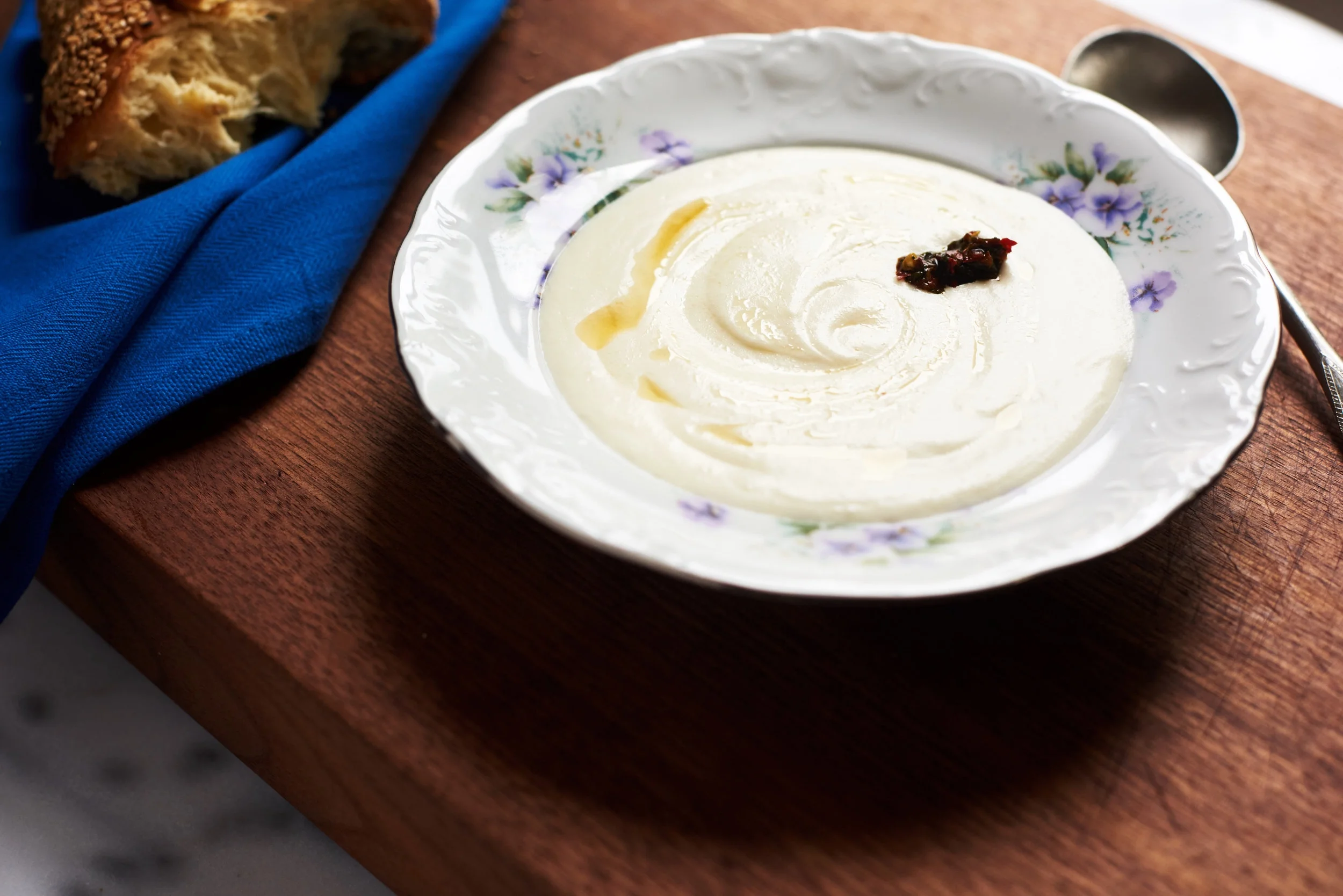A Break-Fast Meal From Yemen and Morocco
Shared by Rinat Tzadok
Recipe Roots: Yemen and Morocco > Hadera, Israel > Tel Aviv, Israel
Rinat Tzadok’s father, Shlomo, doesn’t know his exact birthday. He was born during his parents’ trek from Yemen to Israel in 1949 as they were making aliyah to the new state.
In their new home, Yemenite cooking remained an essential part of family life. Rinat, who is a baker in Tel Aviv, remembers her grandmother Miriam, the second wife of Rinat’s grandfather, cooking in a “magic little shed” in her yard. Miriam would cook stews over kerosene burners there, blend Yemenite hot sauce called schug from green and red hot peppers that she grew, grind her own flour, and slaughter chickens for a rich soup and Jerusalem mixed grill.
On Saturdays, when Rinat’s father went to synagogue, she would follow him. “I waited for the service to end because that’s when grandma served her signature spread: fresh kubaneh, grated tomatoes, schug, bean stew, white coffee, and sweet black coffee with hawaij,” she says.
For Yom Kippur, Miriam made samnah, a condiment of smoked clarified butter that she infused with burned twigs and leaves. It adds a campfire flavor to a warm Yemenite yogurt soup called zom, which Rinat’s family often ate to break the fast. “My mom put challah in the oven until it was crispy and we’d eat the zom with samnah, schug and challah,” says Rinat. “It’s comforting, it’s hot, and it’s nice after you haven’t eaten for two days.”
Today, in Israel, Rinat’s mother makes zom by mixing 9% and 5% soft white cheeses. In the US, Rinat recommends mixing sour cream, yogurt and water. “I still eat it every year,” says Rinat. “After 38 years this is the dish we eat after Yom Kippur.”
Zom (Warm Yemenite Yogurt Soup)
Photo by Dave Katz
Serves: 4
Total Time: 20 minutes
Ingredients
1½ cups whole greek yogurt
1½ cups sour cream
2 tablespoons flour
1 teaspoon salt, plus more to taste
½ cup water
1 tablespoon fresh lemon juice
Preparation
1. In a small sauce, stir together the yogurt and sour cream over medium heat. Let heat through for about 2 minutes.
2. Meanwhile, in a small bowl, whisk together the flour and salt, then slowly stream in the water until combined without any lumps.
3. Stir the flour mixture into the yogurt mixture and cook until thickened (should resemble a raita in consistency), 10 to 12 minutes.
4. Remove from heat and stir in lemon, then adjust the seasoning with salt. Serve warm with kubaneh or challah.
Harira
Photo by Armando Rafael
In Rinat’s family, the cooking is a blend of recipes of her mother’s Moroccan roots and her father’s Yemenite traditions. On erev Yom Kippur (the day the fast commences), her mother Rachel would serve couscous for lunch, while dinner that evening was made by her step-grandmother Miriam who prepared Yemeni broth served over a loose dough or porridge called aseed (also spelled asida).
To break the fast, soup appeared on the family table again — some years it was Yemenite zom, while other years, when her Moroccan grandfather Moshe cooked, there were bowls of hearty harira made with lentils, egg noodles, bunches of fresh herbs, and chickpeas. Breaking a fast with harira is a tradition that’s shared across Moroccan communities. “Moroccan Jews follow the custom of their neighbors, who eat harira… after the fast of Ramadan,” explains Gil Marks in “The Encyclopedia of Jewish Food.”
For Rinat and her family, “preparing harira soup is a whole ritual,” she explains, from soaking the chickpeas to peeling them by hand to cooking the soup for hours, it helped mark the holiday in her childhood home in Hadera.
Serves: 6
Time: 2 hours 15 minutes
Ingredients:
1 cup dried chickpeas, soaked overnight and drained
3 tablespoons olive oil
4 stalks of celery, diced
1 large onion, diced
3 garlic cloves, minced
1 teaspoon fresh turmeric, minced, or ½ teaspoon ground turmeric
1 tablespoon kosher salt
½ teaspoon ras el hanout (spice blend)
¼ teaspoon ground black pepper
¼ teaspoon dry chilli flakes
1 cup brown lentils, soaked for 6 hours
4 large tomatoes, roughly chopped or grated
3 cups egg noodles
1 teaspoon maple syrup (optional)
Juice of half a lemon
For serving:
¼ bunch parsley, roughly chopped
¼ bunch cilantro, roughly chopped
Preparation:
1. Bring a pot of water to boil, and cook the soaked chickpeas for 40 minutes, drain and set aside.
2. Heat the olive oil in a large pot over medium heat. Add the celery, onion, garlic, and fresh turmeric, and saute until softened, about 8 minutes.
3. Add the salt, ras el hanout, black pepper, and chili flakes, (and ground turmeric if not using fresh). Stir to combine and cook for 1 minute to bloom the spices. Add tomatoes, chickpeas, soaked lentils, and 5 cups of water. Mix well, and bring to a boil. Reduce to a simmer, and cook for 1 hour until the soup thickens.
4. Use an immersion blender to puree half the soup. Add in the egg noodles and cook until al dente. Remove from the heat, add the lemon juice, taste and adjust seasoning if needed. If you like, add a teaspoon of maple syrup to cut the acidity from the lemon juice.
Note: For a shortcut, you can use 15 ounces canned or frozen chickpeas.







